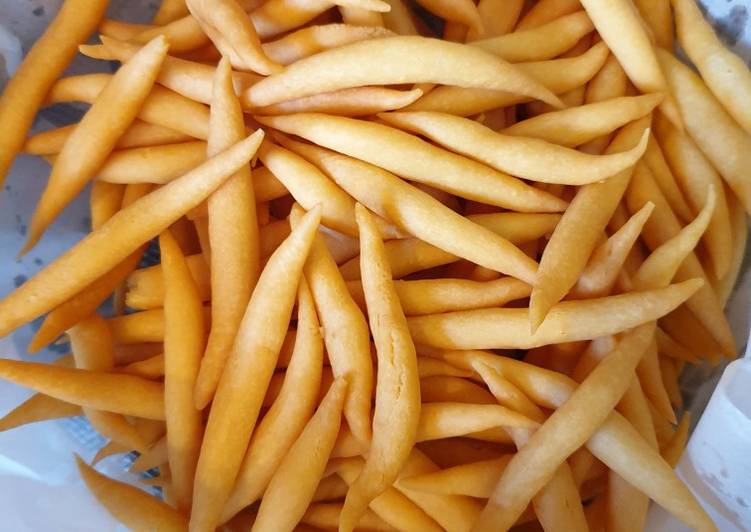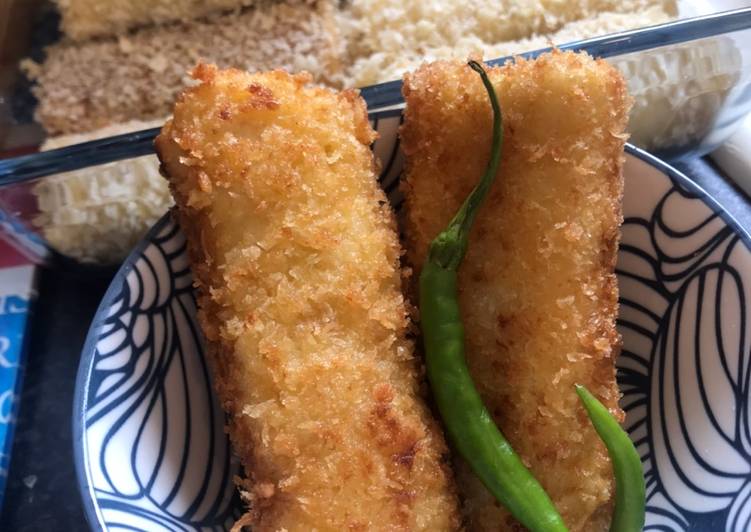
Hello everybody, it’s me, Dave, welcome to my recipe page. Today, I will show you a way to prepare a special dish, indonesian traditional cheese sticks (telor gabus). It is one of my favorites. For mine, I am going to make it a bit unique. This will be really delicious.
When to eat Indonesian Cheese Stick Telur Gabus Keju. Generally, people eat the snack in all times of the year. Nevertheless, the most popular time to consume Telur Gabus Keju is on the Eid Al Fitr, the biggest Muslim holiday. Hi I'm Yohana from discoverindonesianow.com I would like to introduce a traditional Indonesian cheese stick called "Telur Gabus Keju" or "Bidaran" or "Widaran" as different person calls it differently.
Indonesian traditional cheese sticks (Telor gabus) is one of the most well liked of current trending meals on earth. It is appreciated by millions daily. It is simple, it’s fast, it tastes delicious. They are nice and they look wonderful. Indonesian traditional cheese sticks (Telor gabus) is something that I’ve loved my entire life.
To get started with this particular recipe, we have to first prepare a few ingredients. You can have indonesian traditional cheese sticks (telor gabus) using 6 ingredients and 11 steps. Here is how you cook that.
The ingredients needed to make Indonesian traditional cheese sticks (Telor gabus):
- Prepare 200 g tapioca flour
- Take 50 g all-purpose flour
- Make ready 50 g butter
- Prepare 125 g grated cheddar cheese
- Take 2 eggs
- Get Oil to fry
Zona snack and crackers is your daily snack. Hi I'm Yohana from discoverindonesianow.com I would like to introduce a traditional Indonesian cheese stick called "Telur Gabus Keju" or "Bidaran" or "Widaran" as different person calls it differently depends on one's location. Kue is an Indonesian bite-sized snack or dessert food. Kue is a fairly broad term in Indonesian to describe a wide variety of snacks; cakes, cookies, fritters, pies, scones, and patisserie.
Instructions to make Indonesian traditional cheese sticks (Telor gabus):
- Whisk the butter and eggs together or you can also use mixer
- Add the grated cheese and mix them until the texture becomes soft
- Then mix both flours together, and add quarter of it to the mixture, this time use your cleaned hand to mix
- Keep on adding the flour in batches until you get the right texture, where you can knead the dough without sticking on your hand
- Meanwhile, heat up your pan with low heat, add a lot of oil approx 300ml so that will cover all the sticks nicely
- While the oil is heating up, start making your sticks using your hand and immediately drop it to the oil one by one
- Don't add too many sticks, the sticks will float when it's half Cooked, so make sure there is enough space fro them to float and you can easily toss and turn
- Once they are floating, toss them to ensure they are fully cooked and fry them until colour change to golden
- Remove from oil once you get the colour you need, and place them on the wax paper until they cool down
- Do the same for the remaining dough
- Serve immediately or store them in a jar for whenever you want them. Just make sure that it's an air tight jars so the sticks remain crispy
Kue is an Indonesian bite-sized snack or dessert food. Kue is a fairly broad term in Indonesian to describe a wide variety of snacks; cakes, cookies, fritters, pies, scones, and patisserie. Kue are made from a variety of ingredients in various forms, some are steamed, fried or baked. Kue are popular snacks in Indonesia, which has the largest variety of kue. This little delight savory cookie is called kaastengels in Dutch and kastengel or kue keju in Indonesian.
So that is going to wrap this up with this exceptional food indonesian traditional cheese sticks (telor gabus) recipe. Thanks so much for your time. I’m sure that you will make this at home. There’s gonna be interesting food at home recipes coming up. Don’t forget to save this page on your browser, and share it to your family, friends and colleague. Thank you for reading. Go on get cooking!

